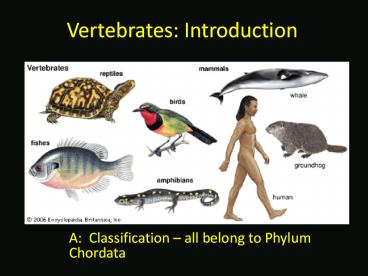Vertebrates: Introduction - PowerPoint PPT Presentation
Title:
Vertebrates: Introduction
Description:
Vertebrates: Introduction A: Classification all belong to Phylum Chordata B: Shared Characteristics Have a backbone encases/protects the dorsal nerve cord (spine ... – PowerPoint PPT presentation
Number of Views:178
Avg rating:3.0/5.0
Title: Vertebrates: Introduction
1
Vertebrates Introduction
- A Classification all belong to Phylum Chordata
2
B Shared Characteristics
- Have a backbone encases/protects the dorsal nerve
cord (spine) - Two sets of paired appendages
- Closed circulatory system (Blood in vessels)
powered by a heart - Breathing apparatus (lungs or gills)
3
The Five Groups!
- 1. Fish
- 2. Amphibians
4
The Five Groups!
- 3. Reptiles
- 4. Birds
5
The Five Groups
- 5. Mammals
6
II. Fish
- Definition
- Aquatic (live in fresh or salt water)
- Have scales, fins and gills (in general
exceptions exist) - Ectothermic (cold blooded)
7
- B Members
- Three types
- Cartilagenous (sharks and rays)
- Bony fishes (salmon, guppies, tuna, eels)
- Jawless Fishes (Hagfish, lampreys)
8
III. Amphibians
- A Definition
- Name amphi both
- bio life
- Most live on land as adults, but breed in water,
and are aquatics as larvae - Eggs lack a shell and may dry out
- Have lungs as adults
- Supplement breathing by respiration through moist
skin - Ectothermic (cold blooded)
9
Members
- Two basic types
- Salamanders
- Frogs and toads
10
IV. Reptiles
- Definition
- Adapted for life out of water (on land)
- Scales on skin (prevents water loss) doesnt
grow, and must be shed - Lungs for breathing
- Eggs covered with leathery shell
- Ectothermic (cold blooded)
11
Members
- 1. Three basic types
- Lizards and snakes
- Crocodilians
- Turtles
12
V. Birds
- Definition
- Body covered in feathers
- Front limbs modified into wings
- Have beaks
- Eggs covered in a chalky shell
- Endothermic (warm blooded)
13
Members
- 27 member of class Aves!
- Includes
- Owl
- Eagle
- Chicken
- Penguin
- Finch
- Pelican
- Duck
- Etc.
14
VI. Mammals
- A. Definition
- Endothermic
- Fur, fat layer under skin, sweat glands in skin
all to regulate body temperature - Mammary glands to produce milk to feed young
- Most are viviparous (young are born alive, not in
egg) - Different kinds of teeth (to match food type)
15
Members
- 1. Three basic types based on reproductive
differences - Placental Animals
- Young develop internally in uterus
- Primates, ungulates, rodents, cetaceans,
carnivores
16
- Marsupial mammals
- Young develop in uterus, but born early in
development - Crawl up mothers fur and into a pouch
- Attach to nipple, continue development
- Koala, opossum, kangaroo
- 2333
233
17
- 1. Monotreme Animals
- Young hatched from eggs
- Fed milk by mother
- Echidna, duck billed platypus































